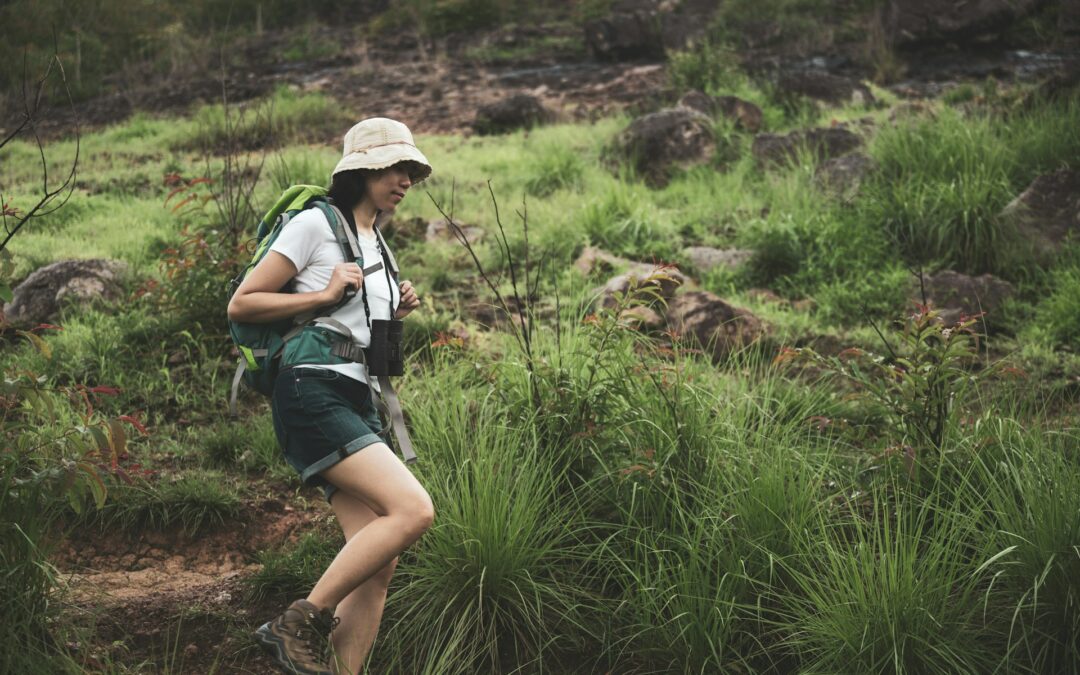Have you ever watched a nature enthusiast walk into a park and immediately seem like they belong? It’s as if the trees, the birds, and the very air recognize them and welcome them back into their fold.
Now, this isn’t some mystical phenomenon. It’s actually quite observable – not only in their faces but also in their body language.
People who regularly spend time immersing themselves in natural environments often exhibit certain physical traits that are distinct from those who live largely indoors. These characteristics aren’t just a result of being out in the fresh air; they’re subtle indicators of a deeper connection with nature.
Intriguing, right?
Well, we’re about to dive into these unique body language traits that nature lovers typically display. So, if you’re curious about how a bond with nature can be reflected through nonverbal cues, you’re in for an enlightening read.
And who knows? You might even recognize some of these traits in yourself or those around you. Let’s explore together.
1. Open body posture
Ever notice how some individuals seem to naturally command the world around them? They have an open body posture that speaks volumes about their comfort and confidence in their surroundings.
This is particularly noticeable in people who regularly spend time in nature. Their posture often suggests a deep sense of belonging and ease within the natural environment. Their shoulders are relaxed, their chest is open, and they move freely, without hesitation or restraint.
This open posture isn’t merely about physical comfort, though. It’s also a reflection of a mindset. It signals openness to experiences, acceptance of the present moment, and a willingness to engage with the world around them in a genuine and unguarded manner.
Now, this might seem like a minor aspect of one’s behavior. But it’s actually quite significant. It speaks to the transformative power that nature can have on our physical and emotional well-being. And it’s something you too could cultivate by spending more time outdoors, immersing yourself in the rhythms and tranquility of nature.
2. A slower pace
A few years ago, I found myself in a hectic cycle of chasing deadlines, attending meetings, and constantly being “plugged in”. The hustle and bustle of life had me moving at warp speed. Then one day, I took a step back and decided to reconnect with nature.
I began to spend time outdoors every day, even if it was just for a short while. It started with walks in the park, then some hiking on weekends, and before I knew it, I was planning camping trips to truly immerse myself.
This regular rendezvous with nature gradually changed not just my mindset but also my physical demeanor. I noticed that my pace had slowed down significantly, mirroring the unhurried rhythm of the natural world around me. My movements became more deliberate and less rushed. I wasn’t walking slower because I was tired or lethargic; I was simply more attuned to the pace of nature.
This change didn’t just stay outdoors. Back at work, friends and colleagues noticed the change too. They said there was a newfound calm about me, a sense of ease that hadn’t been there before.
It was a profound realization for me – this slower pace wasn’t about ignoring the demands of everyday life or disengaging from responsibilities. It was about being more present, more mindful of each moment. It was about aligning my rhythm with nature’s rhythm, allowing me to navigate life’s challenges with greater calmness and clarity.
[brbr_related_stories]
So if you notice someone walking slowly yet confidently through a forest trail or park – not because they’re tired but because they’re soaking everything in – they’re likely a regular visitor to nature’s realm.
3. Eye contact with the natural world
When was the last time you found yourself truly observing your surroundings? Not just glancing around, but really taking in the details – the way leaves flutter in the breeze, how the sunlight filters through the canopy, or the intricate patterns on a butterfly’s wings?
People who regularly spend time in nature often develop a heightened awareness of their surroundings. This heightened awareness is manifest in their body language, specifically in their eye movements. They tend to gaze more intently at their environment, establishing a sort of “eye contact” with nature.
This isn’t about staring blankly into space. It’s about engaging actively with the natural world, observing its details, its changes, its rhythms. It’s about noticing the little things that many of us often overlook – a bird’s flight path, the ripple patterns on a pond, the variety of colors in a sunset.
This kind of focused observation isn’t just a visual experience. It’s also an emotional one. It reflects a deep appreciation for nature’s beauty and an understanding of our place within this vast ecosystem. It’s about recognizing that we are not separate from nature, but an integral part of it.
So when you see someone who seems to be drinking in their surroundings with their eyes, chances are they’re not just looking at nature – they’re connecting with it.
4. Grounded movements
Have you ever noticed how some people seem to move with a certain grace and fluidity in nature? Their movements are purposeful, yet relaxed, as if they are in sync with the natural rhythm of the world around them.
This is a common trait among those who regularly spend time in nature – their movements often embody a sense of groundedness. It’s as if they are not just on the earth, but truly part of it. They walk with a solid connection to the ground, expressing a sense of stability and balance in each step.
These grounded movements reflect a deeper connection to nature and self. It’s not about superficially mimicking the way animals move or trying to blend into the surroundings. It’s about being fully present in the moment, responding intuitively to the environment, and embodying a sense of peaceful co-existence with nature.
This deep connection and groundedness can be cultivated by anyone, regardless of their fitness level or familiarity with the outdoors. All it requires is regular time spent in nature and a conscious effort to tune into one’s surroundings and body.
This is something I’ve personally experienced and spoken about in one of my videos. I delve into how spending time outdoors has helped me to feel more grounded and connected to myself, my environment, and even my relationships. I invite you to watch:
If you find this video insightful and want to dive deeper into my philosophy of living with purpose and authenticity, consider exploring more here. I believe that by fostering this connection with nature, we can enrich our lives in profound ways.
5. Calm facial expressions
In a world that often values busyness and productivity over peace of mind, the simple act of being calm can feel revolutionary. Yet, those who frequently immerse themselves in nature often exhibit this tranquility in their facial expressions.
This isn’t about suppressing emotions or maintaining a poker face. It’s about a deep-seated calm that stems from being in tune with the rhythms of nature, from breathing fresh air, and from simply allowing oneself to just be.
Their faces are relaxed, their brows unknotted, and their smiles genuine. Even in challenging situations, you might notice a serene acceptance that speaks volumes about their inner peace.
It’s as if nature’s tranquility has seeped into their very being, reflecting in their expressions and demeanor. This calmness is more than just a physical trait; it’s an embodiment of the belief that we can navigate life’s ups and downs with grace and resilience, much like how nature endures through changing seasons and weather patterns.
So next time you observe someone with a calm demeanor amidst the chaos of life, chances are they’re spending a good amount of time soaking up the serenity of nature.
6. Frequent physical contact with nature
Ever noticed that some people have a habit of touching trees as they walk past, or running their fingers through blades of grass? It’s not just a random act. For those who spend a lot of time in nature, this is a common trait.
Their connection with the natural world isn’t only visual or auditory; it’s also tactile. They’re often compelled to touch, feel, and engage with their surroundings physically, establishing a deep and visceral bond with nature.
Research has suggested that direct contact with the earth—known as grounding or earthing—can have numerous health benefits, including reducing inflammation, improving sleep, and increasing energy levels.
Individuals who frequently spend time outdoors tend to instinctively understand the importance of this physical connection. They’re not afraid to get their hands dirty or feel the earth beneath their feet. They appreciate nature’s textures—the roughness of tree bark, the smoothness of pebbles, the coolness of water. This tactile engagement further enhances their bond with nature and contributes to their overall well-being.
So when you see someone who seems to be constantly in tactile communion with nature—whether it’s hugging a tree or walking barefoot on grass—they’re likely a frequent visitor to the outdoors.
7. Attentive listening
In our fast-paced, digital world, attentive listening seems to be a dying art. Yet, for those who often find themselves in nature, it’s a practice that’s very much alive.
When you see someone in the outdoors, deeply engrossed in the symphony of sounds around them—the rustling of leaves, the chirping of birds, the gentle babble of a stream—it’s clear that they’re not just hearing these sounds; they’re truly listening.
This kind of attentive listening is a hallmark of people who regularly spend time in nature. Their body language—tilted heads, closed eyes, and relaxed postures—reflects their full engagement with the soundscape around them.
It’s not just about enjoying pleasant sounds, though. This engaged listening reflects a deeper understanding and appreciation for the intricate web of life that unfolds in nature’s soundtrack. It’s about being fully present and honing in on the subtle nuances that often go unnoticed in our everyday hustle.
So next time you come across someone seemingly lost in the music of nature, know that they’re likely a regular visitor to the great outdoors. Their attentive listening is not just an appreciation for natural sounds but a testament to their deep connection with the world around them.
Embrace your nature connection
If you’ve found yourself reflecting on these traits and recognizing them within yourself, it’s a strong indicator of your deep bond with nature. It’s not merely about spending time outdoors; it’s about how you interact with the natural world, how you resonate with its rhythm, and how it influences your body language.
But, understand this – these traits aren’t exclusive to a select few. They are accessible to all of us. All it requires is the willingness to step outside, to engage with nature, to tune into its subtle cues and rhythms.
You may start noticing changes in your body language, as we’ve discussed in this article. But more importantly, you’ll likely experience shifts within – in your mindset, in your attitudes, and in how you navigate life’s challenges.
Now, if you’re wondering how to deepen this connection or perhaps struggling with a particular aspect of your life, I have something that might help.
I recently created an AI tool called Wake-Up Call. It’s designed to give you the nudge you need to shift from living on autopilot to taking control of your destiny. Based on my library of online courses and YouTube videos, this tool understands your unique situation and provides the most impactful message you need right now.
All it requires is for you to ask a question about some aspect of your life. The tool will then hone in on giving you advice specific to your situation. It’s like having a personal coach available at any time, ready to provide insights tailored to what you’re dealing with in life.
You can access this free tool here.
Remember, each one of us has the potential to form a profound connection with nature and tap into our inherent creativity and resilience. It’s not just about changing our body language; it’s about changing our lives for the better. So, step outside, soak in the beauty of nature, and embrace the journey of personal growth and transformation.









